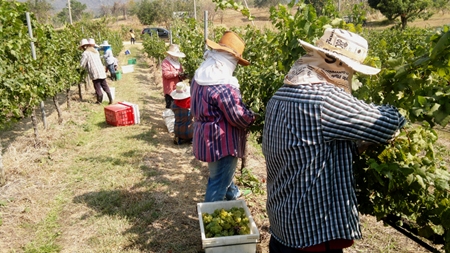The new 2010 vintages have just been released from the Khao Yai winery, including the new “Sawasdee” wines. Even if you are new to Thailand, you’ll have discovered that “Sawasdee” is the everyday greeting in these parts. Prayut Piangbunta, the Director & Chief Winemaker at Khao Yai writes, “When we launched our fresh and fruity wines on to the market, the name Sawasdee was chosen, because there is no word which can represent ‘Thai-ness’ better.” These wines are sometimes available at Foodland, Villa, Eataly (Jomtien) and Aroy Italy on Sukhumvit Road (near King Power).
“Sawasdee” PB Valley Chenin Blanc 2010 (white), Thailand (Bt. 390, various outlets)
Chenin Blanc is a white wine grape from the Loire valley of France. It was first mentioned in 845 AD in the records of a Loire abbey. The grape has over thirty other names but (you will be relieved to know) I shall not list them here.
 Harvesting at Khao Yai vineyard.
Harvesting at Khao Yai vineyard.
This particular Chenin Blanc (SHEN-ihn BLAHN) was made from grapes grown in Thailand. It’s a light straw colour and looks fresh and young in the glass. It has a delightful and rather elegant aroma of fresh pineapples, a touch of pepper and light spice, if you can imagine that. The taste comes out a little drier than expected with just the faintest hint of sweetness. On the palate, you’ll get the soft fruity taste of pineapple and passion fruit and a lovely touch of mild acidity. There’s a longish, lingering finish too, that suggests citrus and a dash of dry herbs. It really is very Thai.
At just 12.5% alcohol, this wine is a delightful easy-drinker and would make a terrific apéritif to perk up the taste-buds. And did you know that the human tongue has between 2,000 and 8,000 taste-buds that have to be perked up? It seems an awful lot of taste-buds but dogs, for example, have thousands more. Anyway, I digress, but I thought you’d like to know.
Air contact will help to bring out the aromas in this young wine, so open the bottle well in advance or better still, pour the whole lot into a decanter or carafe. Be sure to serve the wine really quite cold. The makers suggest about 8°-10° C (46°-50° F) but a few degrees lower wouldn’t do it any harm.
“Sawasdee” PB Valley Shiraz 2010 (red), Thailand (Bt. 390, various outlets)
This is a purple-red colour and has an attractive aroma of fresh black cherries and freshly-ground black pepper. Being a young wine, it takes a little time for the aroma to develop, so do give it time. There’s a lovely fresh taste, with loads of fruit up-front and a pleasing dash of tannin. The wine is quite light-bodied with a lively mouth-feel and a good foundation of tannin on the finish too.
Some people avoid Shiraz (SHEE-razz) because wines made from this grape can sometimes be very assertive and powerful. But not this. It certainly tastes like a Shiraz, but it has a lovely light touch with an almost spritzy character. It really has that elusive Thai quality. It’s an interesting easy-drinker and I think it would work really well with pizza or pasta. It would make a good partner for dishes like Quiche Lorraine or light cheesy snacks too.
If you’re still at the phrase-book stage of Thai, you may be wondering why the wine is called “Sawasdee” and not “Sawat dee”. It is all to do with transliteration. One approach is to Romanize Thai words to reflect the original Thai spelling. Alternatively you can transliterate them to represent the actual sound. When a Thai syllable ends with an “s” it is sounded as a “t”, so you can write either “sawas” or “sawat”. Similarly, syllables ending in “l” are sounded “n” which is why you often see “Chonburi” written as “Cholburi”. Just to make it more interesting, syllables ending in “j” are sounded as “t” and syllables that end in “r” are sounded as “n” except on alternate Thursday afternoons they are not pronounced at all. Of course, I made that last bit up, but I am sure you’ve got the general idea.




